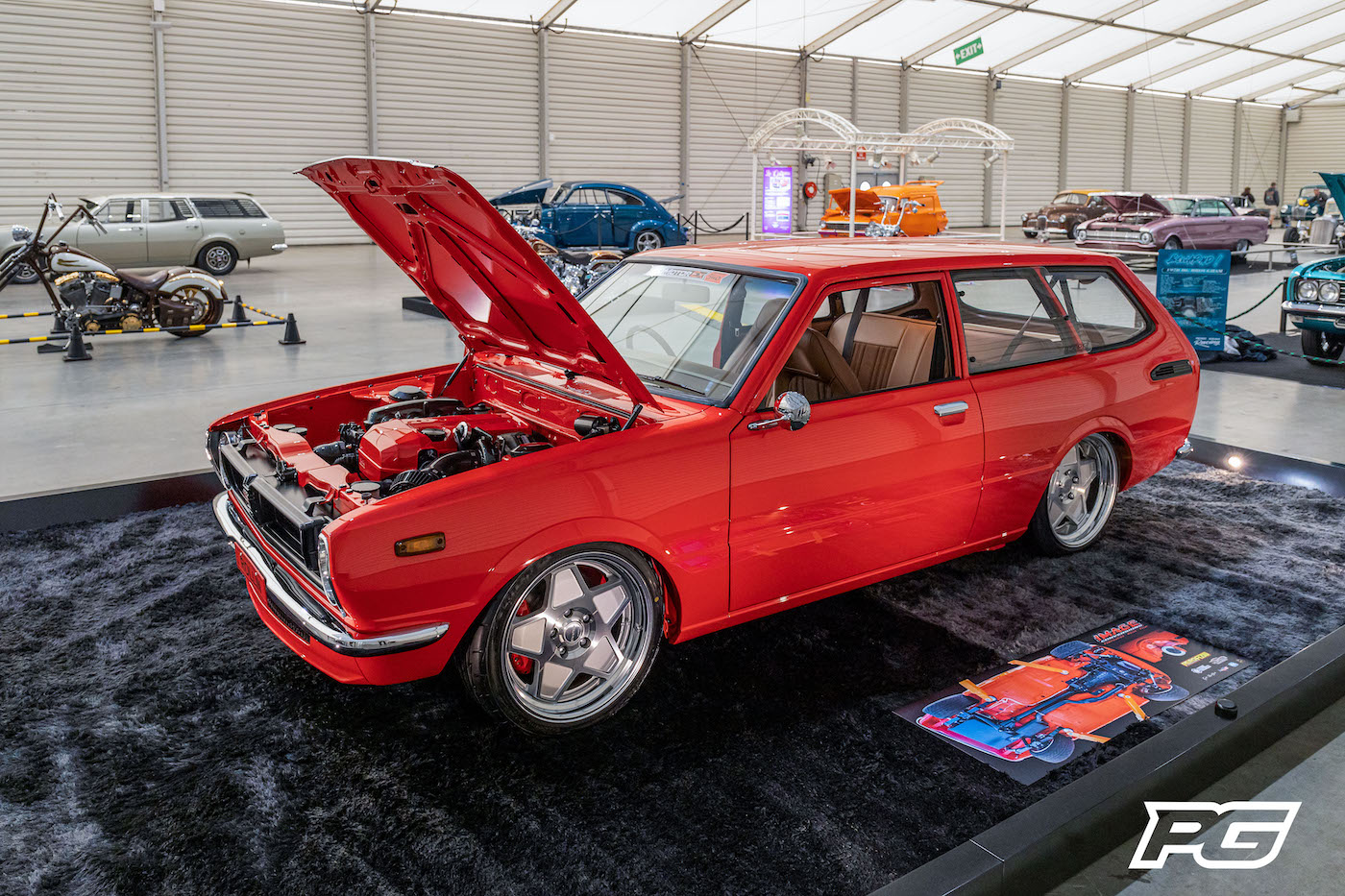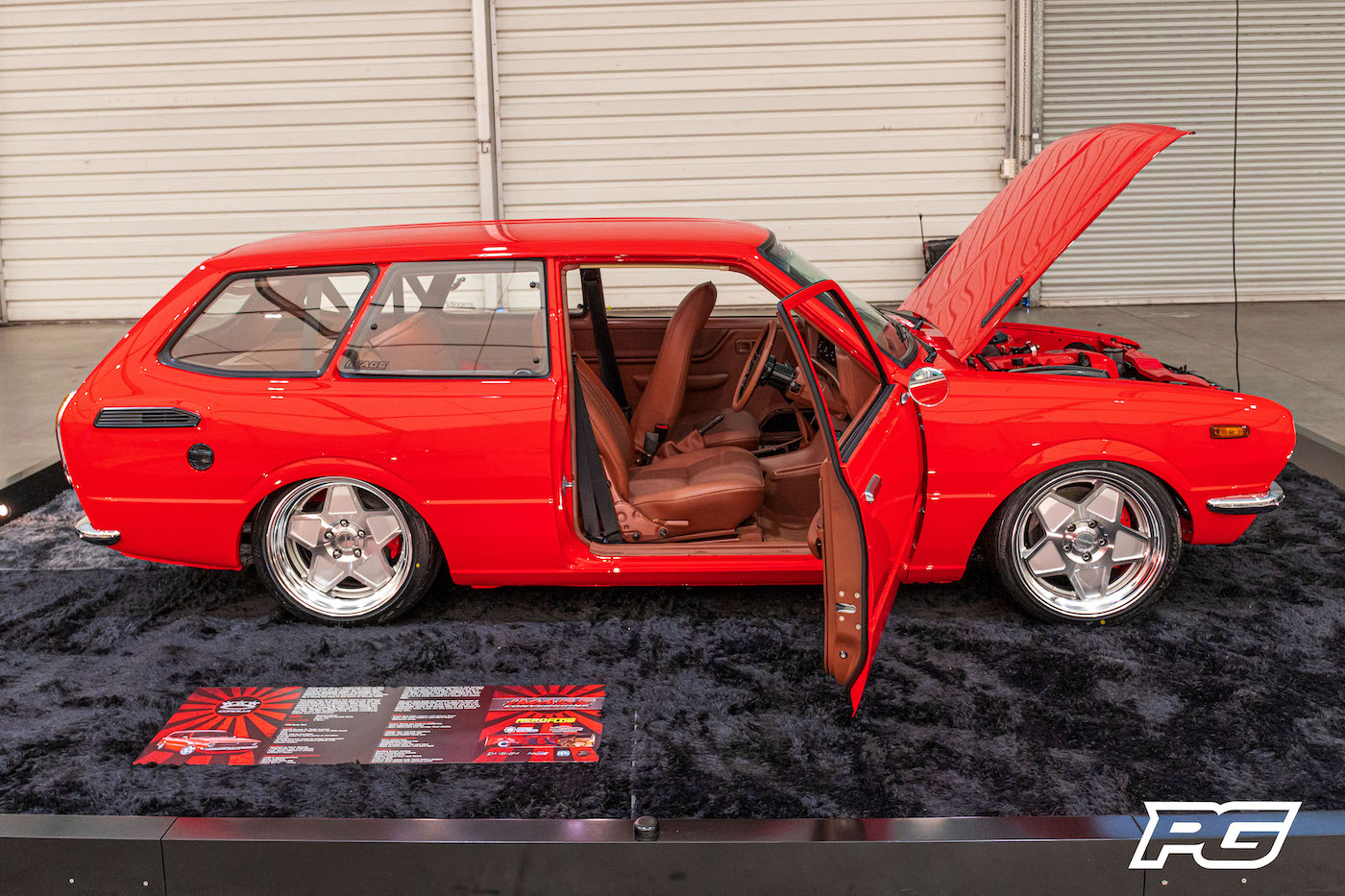Street Elite Turbo BEAMS KE36 Corolla Wagon

Updated: 30.11.2023
KE36 Toyota Corolla
Image Conversions head honcho Michael Ellard has always had a love for early model Toyota Corollas, and his epic 1974 KE36 Toyota Corolla wagon was hot property at Meguiar’s MotorEx in 2022.
What was supposed to be a slight restomod weekender, is now a fully custom two-door station wagon with an elite interior and exterior to match. One of the biggest changes would be the Japanese model KE36 two-door wagon conversion, replacing the factory Australian-spec van panels. Michael wanted to keep an original look to the car, only adding some minor tweaks that gave the car its own unique look and style.

The rear end has been tubbed to fit some gorgeous dished wheels and accommodate the low stance, while the interior has been custom trimmed to a refreshed OEM plus look with gloss black accents. Rounding out the look, the car features KE20 front and rear bars moulded to fit and then dipped in a gorgeous factory red paint job.
Aeroflow T28 Turbo
Under the hood lies a 3S-GE Beams motor out of a Toyota Altezza with an Aeroflow T28 turbo strapped to the side to make a nifty 350kW at the wheels. Michael is stoked with the car and was amped with how well received it was at Meguiar’s MotorEx in April. The plan now is to get it out and use it as much as possible! You’ll spot this little wagon at drag racing meets, cars and coffees and everything in-between.
The KE36 Engine - in Detail
The KE36 engine is a vintage 4-cylinder engine that was produced by Toyota and used in several popular models from the late 1960s through the early 1980s. Known by enthusiasts as the 3K, 4K, 5K, and 7K engine family, these compact and reliable powerplants have stood the test of time.
Overview
- Displacements ranged from 1.0L to 1.4L
- OHV design with timing chain-driven camshaft
- Produced from 1969-1982
- Models powered by KE36 engines:
- Toyota Corolla
- Toyota Sprinter
- Toyota LiteAce
- Toyota TownAce
This engine gained popularity due to its:
- Proven reliability
- Ease of maintenance
- Affordability of parts
- Strong aftermarket support
While only making modest power from the factory, its lightweight inline-4 design allows the KE36 engine to rev freely and enables excellent capability for modifications.
Evolution
The KE36 engine evolved through several versions over its lifespan:
- 3K - 1.0L, 69hp
- 4K - 1.2L, 75hp
- 5K - 1.2L, 83hp
- 7K - 1.4L, 100hp
Each variant brought incremental improvements in technology, efficiency, and durability. Parts remained interchangeable between versions, showcasing Toyota's mastery of modular design.
| Engine Model | Displacement | Horsepower | Production Years |
|---|---|---|---|
| 3K | 1.0L | 69hp | 1969-1982 |
| 4K | 1.2L | 75hp | 1969-1982 |
| 5K | 1.2L | 83hp | 1969-1982 |
| 7K | 1.4L | 100hp | 1969-1982 |
Popular KE36 Engine Models
The KE36 engine family powered several key Toyota models from 1969-1982:
- Toyota Corolla
- One of the most popular applications
- Used across multiple generations
- Favored by tuners for its sporty, lightweight RWD platforms
- Toyota Sprinter
- Close mechanical relative to the Corolla
- Shared drivetrain components with Corolla
- Ideal for engine swaps
- Toyota LiteAce
- Rear-wheel drive configuration
- Utilised the largest 1.4L 7K variant
- Truck applications benefited from extra torque
Enthusiasts target specific models for increased performance builds:
- Corolla coupes - popular sports car platforms
- Sprinter - lightweight package
- LiteAce - RWD drivetrain
With strong interchangeability of parts between KE36 engine variants, owners have flexibility for customisation.
KE36 Engine Parts and Maintenance
The KE36 engine has proven to be durable, but routine maintenance is still required, especially on high-mileage units. Common wear items include:
- Timing chain - Can stretch over time, causing timing issues
- Oil seals - Age and heat can cause sealing failures
- Gaskets - Will need periodic replacement
Fortunately, parts availability remains excellent through suppliers like:
- OEM dealers
- Online retailers
- Salvage yards
Some maintenance items DIYers can perform:
- Oil and filter changes
- Spark plug replacement
- Drive belt inspection
While more involved repairs may need shop equipment:
- Valve adjustments
- Head gasket replacement
- Engine overhauls
Timing chain kits and full gasket sets help simplify repairs and restoration projects. With basic tools and patience, the KE36 engine is straightforward to service compared to more modern designs. Proper maintenance is key to preserving these engines for years to come.
Modifying and Upgrading the KE36 Engine
Overview: Upgrading the KE36 engine, a classic engine from Toyota, requires careful consideration of various factors like the engine's compatibility, reliability, power, and budget. The KE36, associated with the vintage Toyota Corolla, offers various upgrade paths. Popular modifications include engine swaps, transmission upgrades, and improving engine components.
Engine Swap Options:
- Popular Swaps: Swaps like SR20DET, RB20DET, 3SGTE, or turbo Altezza engines are common but require significant modifications like altering the firewall and gearbox tunnel.
- 5K Engine: A 5K engine swap is a viable option, offering a balance of affordability and ease of installation.
- 4A-GE Engine: A silver or black top 4A-GE engine is recommended for those seeking a balance of power and reliability without necessarily going turbo.
- Other Considerations: The 4G63T and 1GGTE are also mentioned as potential swaps, although they come with their own challenges.
Transmission Upgrades:
- 5-Speed Gearbox: Two types of 5-speed gearboxes fit the KE Series - one from the KE55 Coupe and the other from the KE70. Both are compatible with 3K-4K-5K engines but may require modifications like cutting a hole in the floor and changing the gearbox mount.
Basic Engine Upgrades:
- Essential Replacements: New leads, spark plugs, rotor, coil, resistor, dizzy cap, and fuel filter are basic upgrades.
- Cooling System: An alloy radiator, new heater hoses, and coolant are important for maintaining optimal engine temperature.
- Oil System: Regular oil changes, new oil pressure switch, and gearbox oil change are crucial for engine longevity.
- Suspension and Brakes: Installing new brake lines, brake fluid, and tires enhance safety and performance. Upgrading the suspension with new struts, springs, and bushings improves handling.
The Future of the KE36 Engine
The KE36 engine, synonymous with the vintage Toyota Corolla, continues to captivate the hearts of classic car enthusiasts. As we look to the future, three key trends emerge that will shape the legacy of this remarkable engine.
Continued Popularity in the Vintage Toyota Community
The classic appeal of the KE36 is undeniable. This engine has a special place in the vintage Toyota community, thanks to its robust design and historical significance. Enthusiasts and collectors often showcase these engines in classic car shows and Toyota-specific events, ensuring their ongoing interest and recognition. Online forums and social media groups dedicated to the KE36 and vintage Toyota models play a crucial role in fostering a strong community. They serve as hubs for knowledge sharing, where enthusiasts from around the world connect, discuss, and celebrate their shared passion for this classic engine.
Preserving and Restoring These Engines for Future Generations
Preservation is at the heart of keeping the KE36 legacy alive. Restoration projects focus on bringing these engines back to their original glory, often using authentic parts like the 13540-21020, 13521-21020, and 13523-21020. These efforts are not just about maintaining the engines but also about preserving a piece of automotive history. The challenge of sourcing rare parts like timing chain kits or specific metal components has created a niche market, vital for the restoration process. Additionally, knowledge transfer through online tutorials and workshops helps in passing down the skills required for restoration to younger enthusiasts, ensuring that the art of preserving these engines continues through generations.
Potential for Growth in Customised and Upgraded KE36 Builds
The customisation and upgrading of KE36 engines represent an exciting frontier. There's a growing interest in modifying these engines with modern upgrades, like the 5k or 4k engines, or even more radical swaps like the SR20DET or 3SGTE. This trend speaks to the versatility of the KE36 and the creativity of its enthusiasts. Incorporating modern technology, such as advanced fuel and oil systems, opens up possibilities for performance enhancements while maintaining the vintage essence of the engine. With the global reach of the vintage car hobby expanding, the KE36 is gaining attention in various countries, not just in its homeland of Japan. This global interest could lead to an increase in customised and upgraded KE36 builds, blending the old with the new in fascinating ways.
Comments
No posts found










